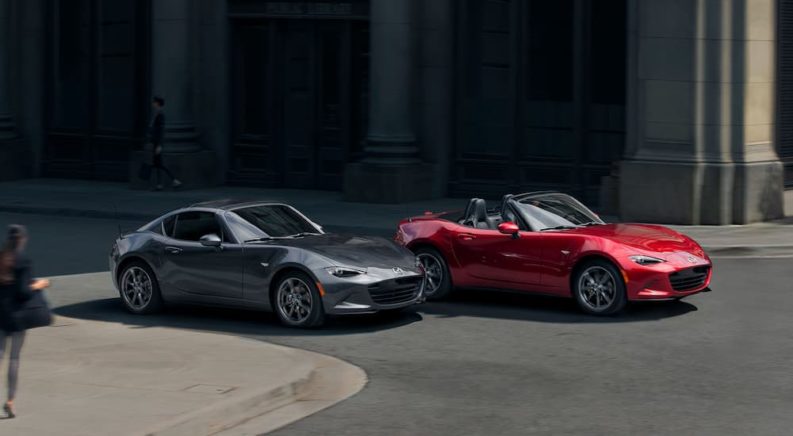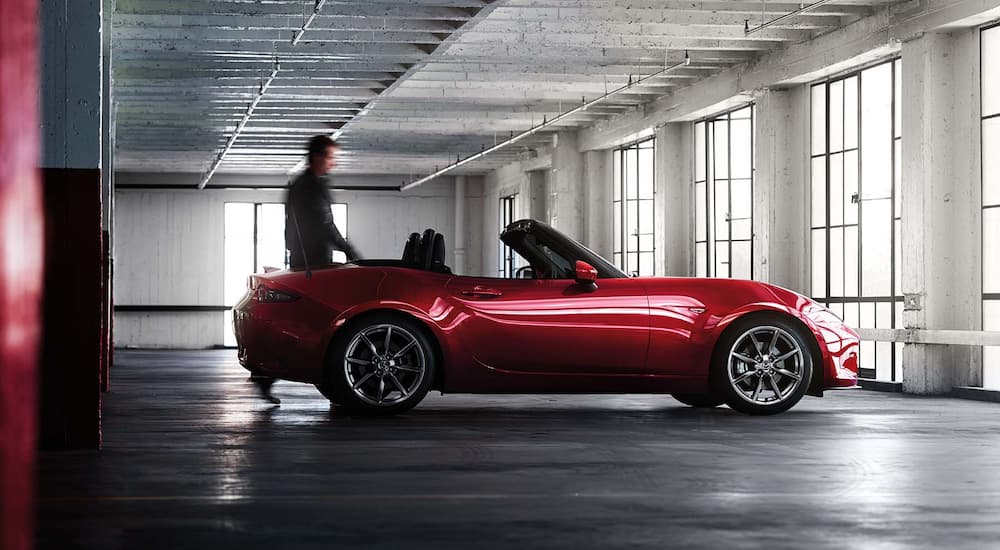Modern sports cars have been getting faster, a lot faster. Speed is an easy metric to measure, and modern engineering is delivering more powerful engines than ever before, creating an arms race that makes the days of classic muscle cars look like a friendly competition. Affordable pony cars like the Ford Mustang GT and Chevy Camaro SS now run the quarter-mile in the low 12 seconds stock, while higher-end models like the Porsche 911 Turbo and BMW M5 are putting down numbers in the 10-second range. In a market like this, is there still a place for lightweight roadsters like the 2022 Mazda MX-5 Miata with its leisurely 15.1 second quarter mile?
This is becoming a particularly acute question as electric vehicles threaten to take over the performance car market. The raw power available from electric motors can turn even a full-size four-door sedan like the Tesla Model S into a performance powerhouse so fast that repeated launches can physically nauseate the driver. Higher-end sports car brands have already committed to developing electric replacements for their own iconic roadsters, with cars like the Porsche 982 Boxster and Lotus Elise being phased out for new models promising more power and electric acceleration, but the need for large battery packs means the new models are anything but lightweight.
The Miata Spirit
The Mazda Miata has always been a bit of an outlier when it comes to sports cars. Designed in the late 1980s, the MX-5 Miata was never intended to be Mazda’s premier performance car. Sold alongside the legendary RX-7 and the less well-known MX-3, MX-6, and Cosmo, the original Miata was designed for the sole purpose of being a lightweight roadster that would offer the same driving experience as the popular British roadsters of the 1950s in a more affordable and reliable package.
While the 1989 RX-7 pumped over 200 hp from its cutting-edge turbocharged rotary engine, the 1989 MX-5 contented itself with barely 100 hp from a relatively pedestrian 1.6L four-cylinder borrowed from the Mazda sedan lineup. It was a car designed purely for the joy of driving, not setting records. And it was this focus on providing a specific experience rather than being the best around that allowed the Miata to thrive even as Mazda’s more impressive sports car models were discontinued.
A sharp economic downturn in Japan combined with the spiraling costs of building a competitive sports car saw manufacturer after manufacturer drop out of the running, resulting in the modern sports car scene where a handful of exclusive brands dominate the segment with rarified vehicles offering unmatched performance at incredible prices. The affordable performance cars that survived were the ones that provided something special beyond the raw numbers. The Subaru WRX offered a rally-inspired heritage. The Ford Mustang cashed in on nostalgia for the days of muscle cars. And the Mazda Miata gave drivers the simplicity of a traditional roadster.

Don’t Mess With the Formula
After 33 years and four generations of evolution, the 2022 Mazda MX-5 Miata, to give the car its full official name, is remarkably similar to the original 1989 model. Not only is it still a two-seat, rear-wheel drive roadster powered by an upgraded version of the same four-cylinder that powers Mazda’s sedans, but even the dimensions are rather close to the original. Measuring 154 inches in length, the 2022 Miata is actually two inches shorter than the 1989 Miata in a world where cars just seem to keep getting bigger.
Mazda did follow the trend of making cars heavier and more powerful, but the growth was remarkably constrained. Tipping the scales at under 2400 lbs, the modern MX-5 is roughly 10% heavier than the original, and the engine output of 181 hp is quite modest when family sedans and SUVs routinely approach or even exceed 300 hp. Staying so close to the basic formula after so long is what has helped make Mazda’s tribute to the old school roadsters an integral part of the Mazda brand long after its trademark turbocharged rotary sports cars became a thing of the past.
While many iconic models built their reputation on specific mechanical elements, such as the rotary engine of the RX-7, the rear-mounted boxer engine of the 911, or the small-block V8 of the Corvette, the Miata shows that a reputation can be built on something more intangible. However, this isn’t to say there aren’t mechanical elements that make the modern Miata what it is today. The combination of a responsive naturally-aspirated engine, manual transmission, and rear-wheel drive is a large part of what gives the Miata its playful nature, along with its lightweight and convertible body style.
Where Can Mazda Go?
There have been a lot of conflicting rumors about the future of the Miata, and that could be because Mazda’s best course of action remains unclear. Mazda clearly believes in the future of the gasoline engine and has recently revealed a brand-new inline-6 that will power its new generation of SUVs. Further, Mazda’s only electric vehicle, the MX-30, is a rather uncompetitive model with a range of just 100 miles. This means it is unlikely that Mazda plans to follow in the footsteps of Porsche or Lotus and turn the Miata into a high-speed electric vehicle. However, regulations mean that simply keeping the Miata as-is isn’t a long-term strategy.
Mazda has indicated that it is perfectly willing to keep the current generation of Miata around for a decade or longer, meaning that the 2022 model is barely halfway through the fourth-generation run. Still, a new design will be needed by the late 2020s, and Mazda desires to electrify all of its models before 2030. Rumor is that the fifth-generation MX-5 Miata will arrive sometime around 2026 and will be powered by a 2.0L SkyActiv-X high-compression gasoline engine supplemented by a 48V mild-hybrid system. This would allow Mazda to keep the car lightweight and continue offering it with a manual transmission. But is this really the best course of action?
The Next Miata Should Be Electric
While Mazda can undoubtedly build an enjoyable roadster with the rumored SkyActiv-X engine, doing so may be missing the forest for the trees. Resorting to elaborate technical workarounds to keep a four-cylinder gasoline engine under the hood is not necessarily the purest expression of the traditional roadster experience. As many recent BMW models show, a 48V mild-hybrid system tends to reduce driver feel, removing the free-revving naturally aspirated nature that the Miata embraces for something similar to the old turbocharged engines that didn’t respond linearly to driver inputs.
Instead, Mada has a chance to fully embrace electrification and take advantage of its unique benefits to continue building a fun driver’s car. Just like always, an electric Miata could borrow a powertrain used by Mazda’s mass-market vehicles, tweaking it to reduce weight. The motor from the new MX-30 offers 143 hp and 200 lb-ft of torque, making it more than sufficient for a lightweight roadster. While it is possible to put a manual transmission in an electric vehicle, it isn’t necessary to maintain the Miata spirit. The linear power delivery of an electric motor is perfectly suited to the Miata’s responsive handling, and the lack of engine noise complements its top-down nature.
The real challenge in building an electric Miata that maintains the lightweight roadster experience is managing weight––but this is a place where Mazda has always excelled. The CX-30 is actually an excellent example as Mazda sacrificed range intentionally to keep the weight down and ended up at a relatively svelte 3,388 lbs. Putting a similar drivetrain into a two-seat roadster rather than a five-seat SUV should be able to get the weight down under 3,000 lbs while maintaining a reasonable range.
Given that a next-generation Miata won’t be needed until around 2026, Mazda has plenty of time to wait for improved battery technology to get the weight down further. In fact, Toyota has already announced that it will begin producing vehicles with solid-state batteries in 2025. These batteries are promised to offer twice the range of equivalent lithium-ion batteries, which would dramatically reduce battery pack weight.
Yes, The Miata Has a Future
While the traditional roadster may appear to be on the brink of extinction, the Mazda MX-5 Miata may actually have a long future ahead of it. The secret is keeping the ultimate goal in sight and not being sidetracked by chasing raw performance numbers or shackling the car to an obsolescent technology. Drivers aren’t buying the 2022 Miata because it’s the fastest sports car around, and they aren’t even necessarily buying it because it has a naturally aspirated four-cylinder and a manual transmission––they’re buying it because it is a unique driving experience that is a throwback to the lightweight roadsters of the past. As long as Mazda can keep its eyes on that fact, the Miata will continue to thrive.





